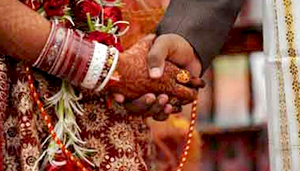Patna, May 10: A woman in Bihar's Buxar district refused to marry a dark-complexioned groom, saying he was not 'smart' enough for her, a police official said today.
 The groom, Anjani Chouhan, was shocked after his would-be-bride refused to marry him citing his dark complexion at the marriage mandap in Ramrekha Ghat in Buxar town, about 125 km from Patna, on Tuesday.
The groom, Anjani Chouhan, was shocked after his would-be-bride refused to marry him citing his dark complexion at the marriage mandap in Ramrekha Ghat in Buxar town, about 125 km from Patna, on Tuesday.
"After Anjani was informed that she had refused to marry him, he requested elders from his family and the bride's side to talk to her and persuade her not to do so as it is matter of honour and dignity in society. But the girl made it clear that she would not marry a dark complexioned man," a district police official said.
According to police officials, the bride was happy during the rituals related to marriage but suddenly told her close family members and friends that she will not marry Anjani because of his dark complexion. Two members of the groom's family approached the police for help. "We told them that police cannot do anything if the girl has refused to marry," an official said.
The upset groom had to return empty-handed along with the marriage party.
It is the second such case in Bihar within two weeks. In a similar case in the last week of April, a woman refused to marry a dark complexioned groom in Samastipur district.
Over half a dozen cases of brides refusing to marry "unsuitable" grooms, on grounds they were illiterate, drunk, deaf or unemployed, have been reported over the past one month.
"Times seem to have changed for women as several schemes have been launched for their empowerment by the state and central governments," said an elderly villager, who was to attend the marriage ceremony.
Several such cases across the state go unreported. In rural Bihar, hundreds of weddings take place in the traditionally auspicious marriage season known as "Lagan", which is in progress now.
Till a few years ago, in rural Bihar it was rare for a woman to refuse a groom selected for her by her parents and family. In fact, the reverse was the rule, as the groom or his parents would often walk out of the wedding venue on grounds of inadequate dowry or the bride's education or her complexion.
These days, women going for marriage on their own terms is not a rarity, even in rural parts of the state.





Comments
Add new comment